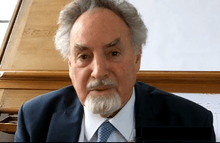Geoffrey Burnstock
| Geoffrey Burnstock | |
|---|---|
 | |
| Born | 10 May 1929 |
| Nationality | Australian |
| Fields | Purinergic signaling |
| Institutions | UCL Medical School |
| Alma mater |
King's College London University College London |
| Notable awards |
Royal Medal (2000) FRS (1986) |
Geoffrey Burnstock FRS FBPhS FMedSci (born 10 May 1929) is a medical researcher and President of the Autonomic Neuroscience Centre of the UCL Medical School. He is best known for coining the term purinergic signaling, which he discovered in the 1970s.[1]
Life and career
Burnstock was educated at King's College London (BSc, 1953) and at University College London (PhD, 1957). He played a key role in the discovery of ATP as neurotransmitter.[2] He was appointed to a Senior Lectureship in Melbourne University in 1959 and became Professor and Chairman of Zoology in 1964.
In 1975 he became Head of Department of Anatomy and Developmental Biology at UCL and Convenor of the Center of Neuroscience. He has been Director of the Autonomic Neuroscience Institute at the Royal Free Hospital School of Medicine since 1997. He was elected to the Australian Academy of Sciences in 1971, the Royal Society in 1986, the Academy of Medical Sciences in 1998 and an Honorary Fellow of the Royal College of Surgeons and the Royal College of Physicians in 1999 and 2000. He was awarded the Royal Society Gold Medal in 2000. He has supervised over 100 PhD and MD students and published over 1400 original papers, re-views and books. He was first in the Institute of Scientific Information list of most cited scientists in Pharmacology and Toxicology from 1994-2004 [59.083 citations (March 2011) and an h-index of 109].[3]
Currently, Burnstock is editor-in-chief of the Purinergic Signalling journal.[4] He is an atheist.[5]
Legacy
His lasting work with ATP-related signalling was first published in the 1970s, which led to a rapid surge in interest in the field and subsequently made him the most cited scientist in pharmacology and toxicology for several years during the 2000s. Much of our understanding of purinergic signaling and the current classification of purinergic receptors is attributed to the work of Burnstock.[6] He was the founding president of the International Society for Autonomic Neuroscience.
According to The New York Times, Burnstock is recognized as "the scientist who brought ATP into the realm of brain research."[7]
References
- ↑ Lewis Wolpert (10 August 2005). "Lewis Wolpert: The Sceptical Inquirer". The Independent. Retrieved 29 November 2013.
He coined the term "purinergic signalling" in 1972 in a key paper that has since been cited more than 2,000 times by other key scientists.
- ↑ GEOFFREY BURNSTOCK: MOST HIGHLY CITED SCIENTIST - 4 (4): 192 - Molecular Interventions
- ↑ Burnstock G. Purinergic signaling in the gastrointestinal tract. World J Gastrointest Pathophysiol. 2011;2(2):31-4. doi:10.4291/wjgp.v2.i2.31
- ↑ "Geoffrey Burnstock". International Congress of Physiological Sciences. Retrieved 4 September 2013.
- ↑ http://www.ucl.ac.uk/ani/Prof/Most%20Highly%20Cited%20Scientist.pdf
- ↑ Di Virgilio, F. (22 October 2012). "Purines, Purinergic Receptors, and Cancer". Cancer Research. 72 (21): 5441–5447. doi:10.1158/0008-5472.CAN-12-1600. PMID 23090120.
Indeed, we owe our present understanding of purinergic signaling and the current classification of P2 receptors to Geoff Burnstock's stubborn activity and enthusiasm
- ↑ Sandra Blakeslee (August 11, 1992). "Finding a New Messenger for the Brain's Signals to the Body". The New York Times. Retrieved 29 November 2013.